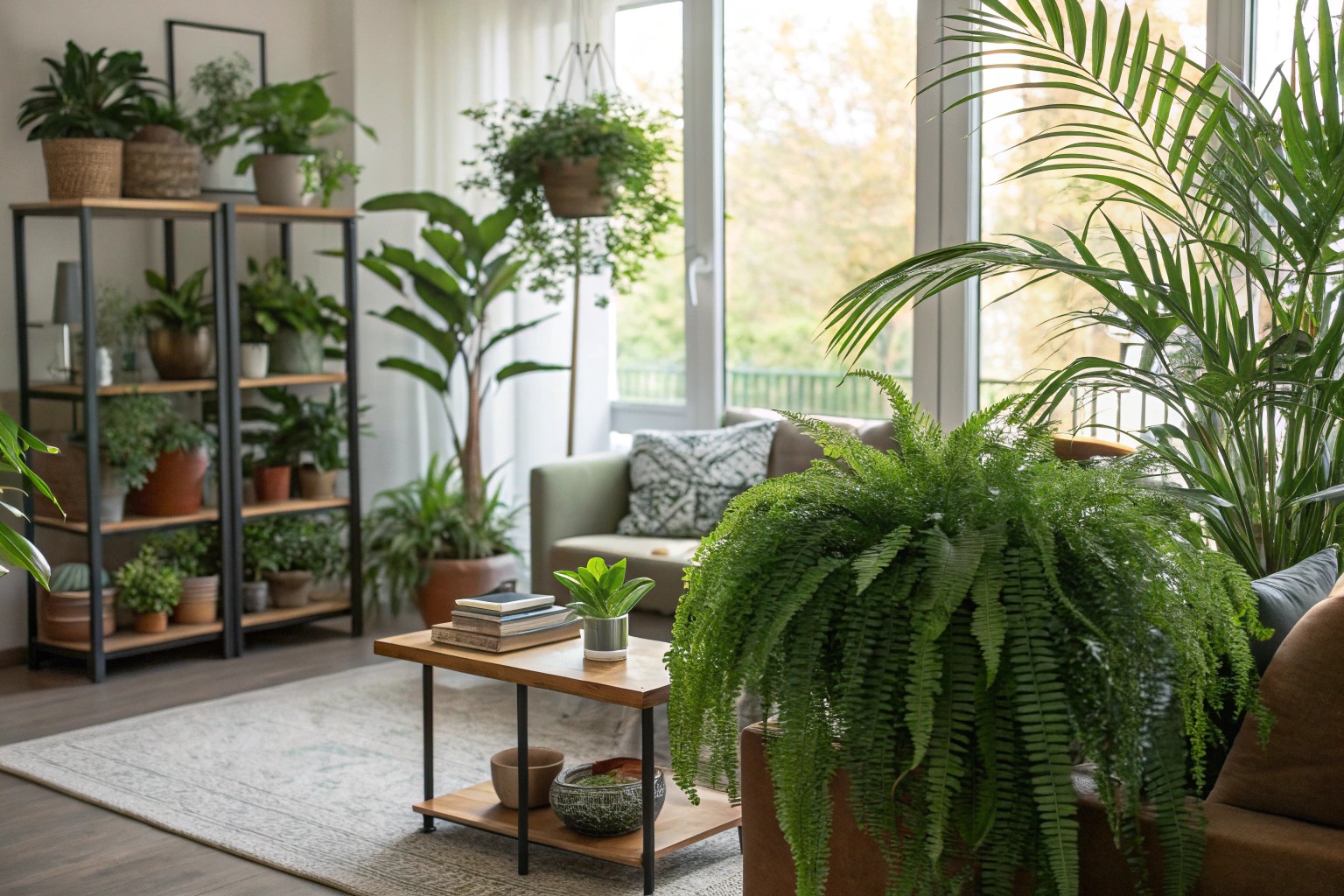Plants transform spaces when thoughtfully styled. As an interior architect who specializes in biophilic design, I’ve witnessed countless rooms come alive through strategic plant placement. This guide explores techniques that elevate potted plants from mere greenery to powerful design elements that define, enhance, and energize your living spaces.
Creating Focal Points with Plants

The most impactful plant arrangements serve as intentional focal points that draw the eye and anchor a space.
The Rule of Odd Numbers
Plants arranged in clusters of three or five create more dynamic, natural-looking compositions than even-numbered groupings.
Designers often emphasize the need for a primary focal point to unify a plant arrangement. This can be achieved through grouping techniques, such as pairing a larger statement plant with one or two smaller companions. It’s also effective to mix different planters and pots that adhere to a consistent color scheme and to incorporate varying plant heights and textures to create a cohesive whole.
Case Study: The Dario Restaurant Transformation
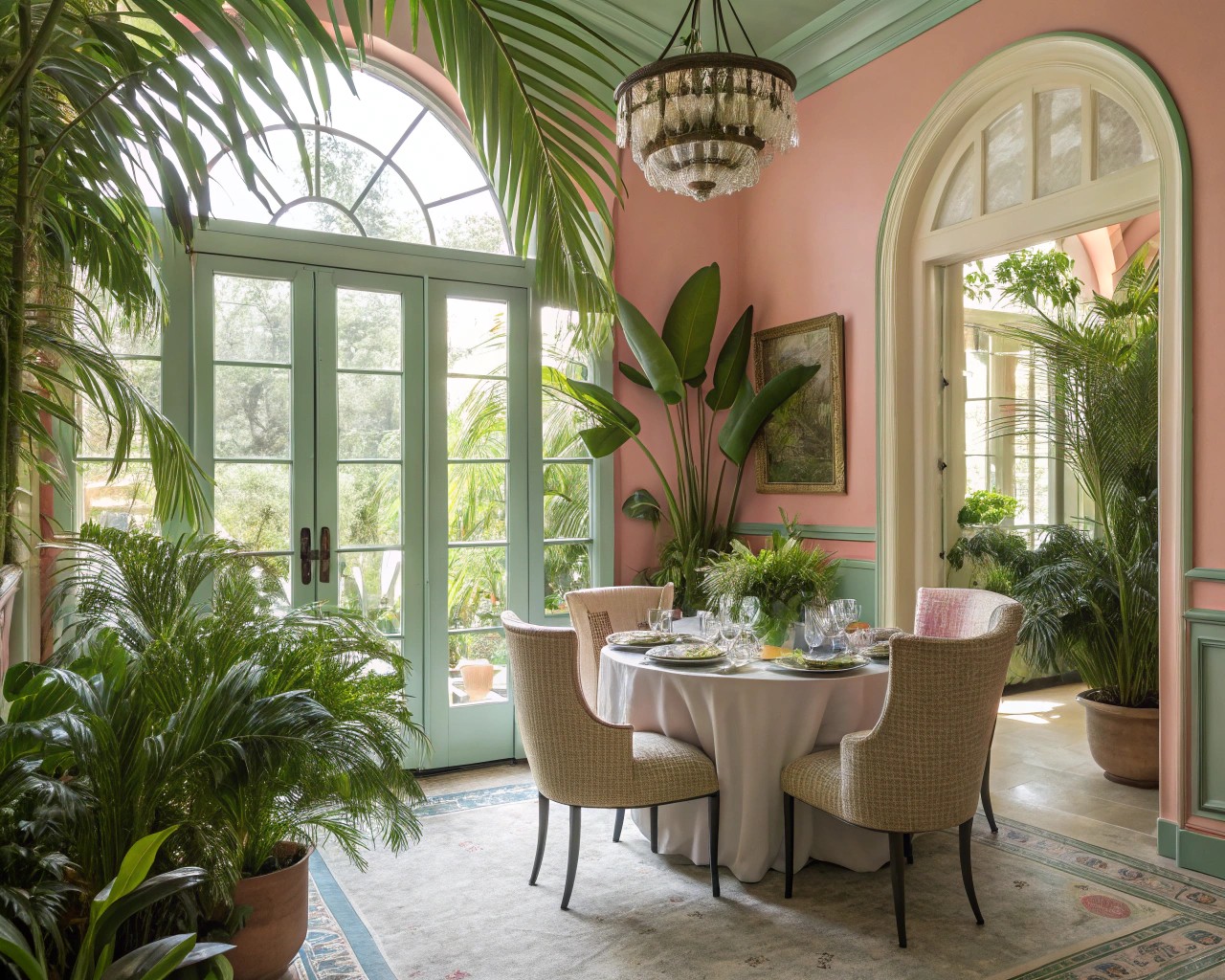
The Dario restaurant project in the North Loop neighborhood demonstrates the power of focal points. With just eight weeks until opening, the team needed to implement the architect’s Miami-inspired vision through strategic plant placement.
Unlike many North Loop venues that embrace the area’s industrial heritage, Dario adopted a different approach. Its design drew heavily on Miami influences, featuring bright colors, curved forms, and soft textures. The architect’s plans specifically called for numerous plants to enhance the intended warm, tropical vibe.
By positioning a magnificent Kentia palm as the central focal point upon entering, supported by clusters of smaller, textured plants, the design team transformed what could have been a typical industrial space into a vibrant oasis that reinforced the restaurant’s unique identity.
The Art of Layering Plants
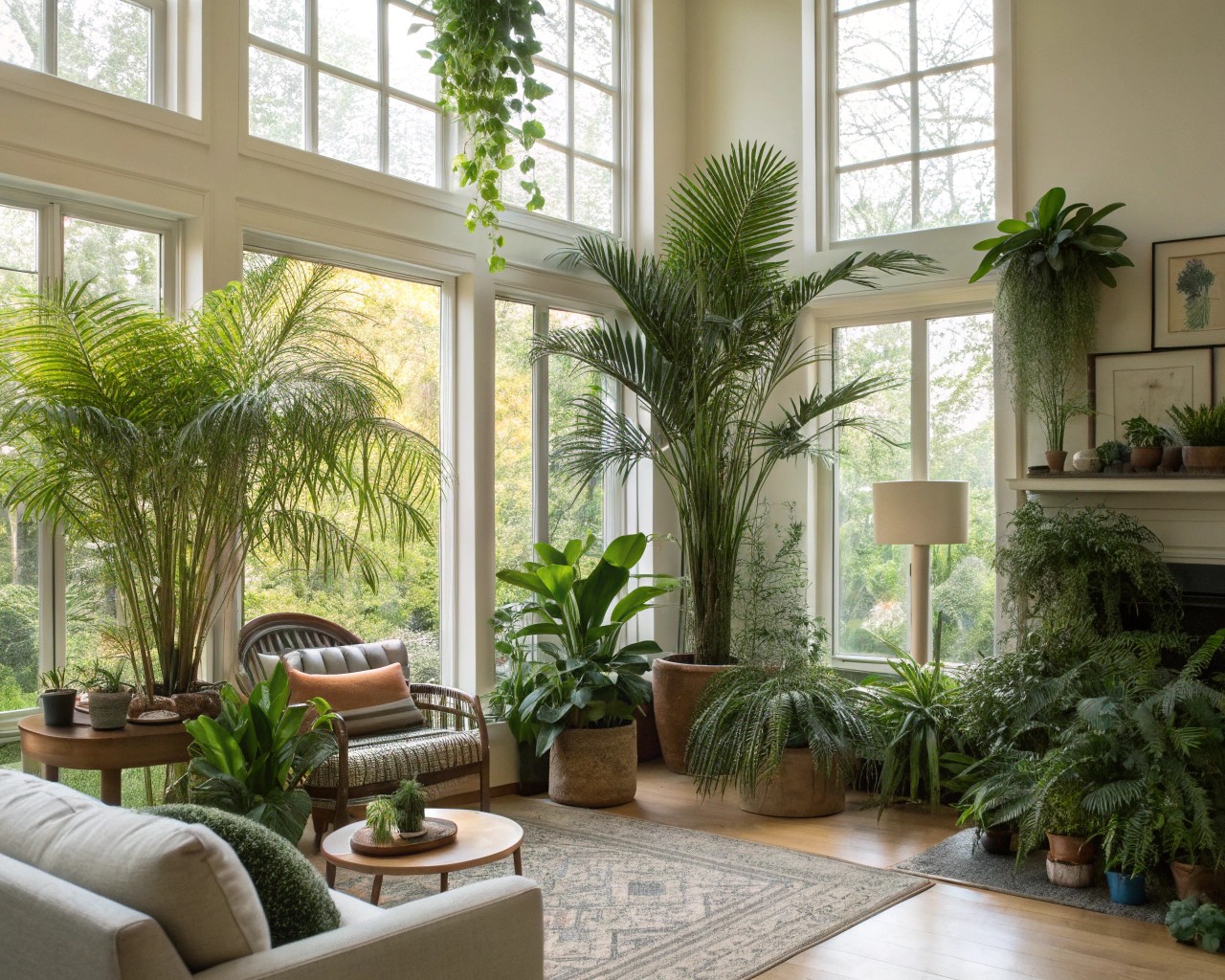
Effective plant styling requires thinking in terms of layers, much like how you would approach the layering of textiles and furniture in a room.
Creating Visual Depth
I learned a valuable lesson about layering from an unexpected source—a college dance professor who emphasized the importance of different levels in choreography.
My professor explained that the most compelling dances utilize high, medium, and low levels. This principle applies equally well to layering plants. The essential idea is to distribute your plants across these different height levels to make the best use of your space and create visual interest.
When we work on residential projects, we create these layers through:
- High level: Tall statement plants like fiddle leaf figs or bird of paradise
- Medium level: Bushy plants at waist to chest height
- Low level: Ground-covering or trailing plants
Unexpected Platforms for Plants
Create unique height variations with these creative platforms:
- Stacked vintage books for small succulents
- Wooden crates or boxes painted to match your decor
- Inverted terra cotta pots supporting smaller planters
- Metal or wooden stools repurposed as plant stands
- Wall-mounted shelving at varying heights
You can achieve a distinctive look by using items like old books or wooden boards as makeshift platforms for your plants. Varying the sizes of your pots is another straightforward method for establishing different levels. Introduce planters of diverse sizes and complementary colors to avoid a monotonous appearance and enhance visual harmony.
Vertical Opportunities: Beyond Floor Space

When floor space is at a premium, the walls and ceilings become valuable real estate for plant styling.
Wall-Mounted Displays
“This has been my thing for the past couple of months. I found these plant clips and have been using them to drape my climbing plants all over my walls. They LOVE it and I am reaping the rewards (bigger leaves)”.
Wall display options for plants include:
- Plant clips for trailing varieties
- Mounted planters in grid or scattered patterns
- Living wall systems with integrated irrigation
- Floating shelves dedicated to small plant collections
- Repurposed picture frames fitted with air plants
Hanging Gardens
Consider hanging plants from ceilings or near window sills to add another dimension to your indoor greenery. When floor space becomes scarce, looking upwards is a practical solution. This approach also provides an excellent opportunity to incorporate decorative macrame hangers or hanging planters that align with your personal style.
For renters or those concerned about permanent installations, consider:
- Tension rods between walls for supporting lightweight planters
- Over-the-door hangers adapted for plants
- Window suction cup holders for small specimens
- Freestanding plant poles that tension between floor and ceiling
Case Study: The Queen’s Wharf Partition
A remarkable example of vertical plant use comes from the Queen’s Wharf project:
“We used 569 plants to create a natural partition between the hotel lobby and the Japanese restaurant. This design achieved both visual impact and functional space division”.
This project demonstrates how plants can define spaces architecturally while maintaining visual flow—a technique you can adapt at home to divide open concept spaces without solid walls.
Styling with Color and Texture
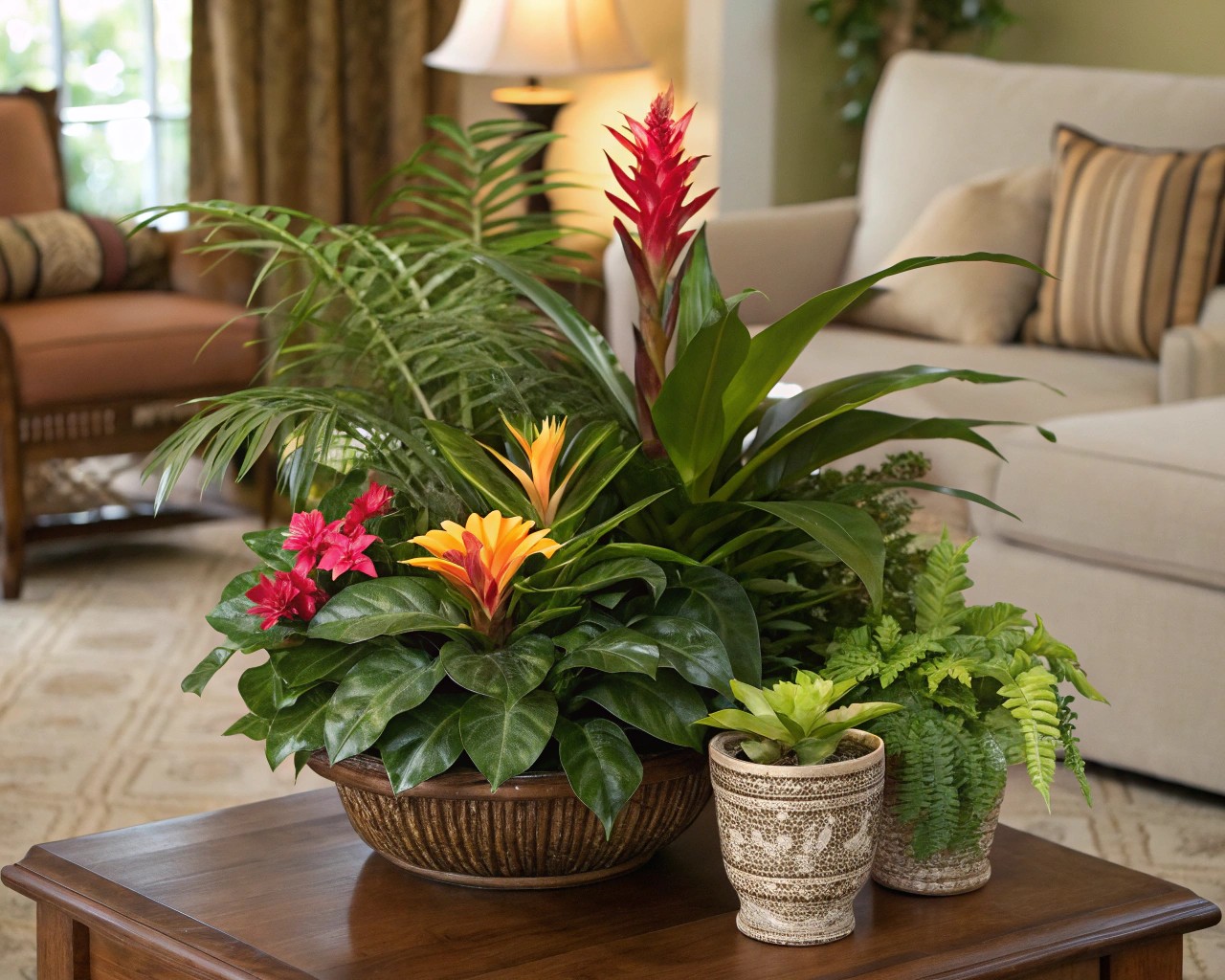
The interplay of plant textures and colors creates depth and interest that elevates basic arrangements to designer-level compositions.
Texture Combinations for Visual Interest
Combining contrasting textures, such as pairing a spiky plant with a softer one like an orchid, or setting a structurally rigid plant against something more flowing, creates visual tension and appeal.
This principle of juxtaposition creates tension and interest in plant groupings. Below is a table of effective texture combinations:
| Architectural Plants | Soft/Fluid Plants | Why It Works |
|---|---|---|
| Snake Plant (Sansevieria) | Pothos or Ivy | Straight vertical lines contrast with cascading movement |
| Fiddle Leaf Fig | Boston Fern | Large, bold leaves complement delicate, feathery texture |
| ZZ Plant | Spider Plant | Glossy, dark foliage balances variegated, arching growth |
| Aloe or Agave | Tradescantia | Sharp, pointed forms soften with trailing, rounded leaves |
| Dragon Tree (Dracaena) | Prayer Plant (Maranta) | Upright structure complements horizontal leaf movement |
Color Stories Through Plants and Pots
Plant styling offers two color opportunities: the plants themselves and their containers.
You can introduce color through vibrant pots, either purchased or by painting simple terra cotta ones to match your decor. Combining these with a mix of colorful flowering or foliage plants results in a cheerful, eye-catching arrangement that can brighten any space.
Popular color combinations that we frequently implement include:
- Monochromatic: Varying shades of the same color for sophisticated elegance
- Complementary: Opposite colors on the color wheel for vibrant energy
- Analogous: Colors adjacent on the color wheel for harmonious flow
- Neutral with Pop: Mostly neutral containers with one bold accent color
- Metallic Mix: Combining copper, brass, silver, and gold finishes for luxe appeal
Container Selection as a Design Element
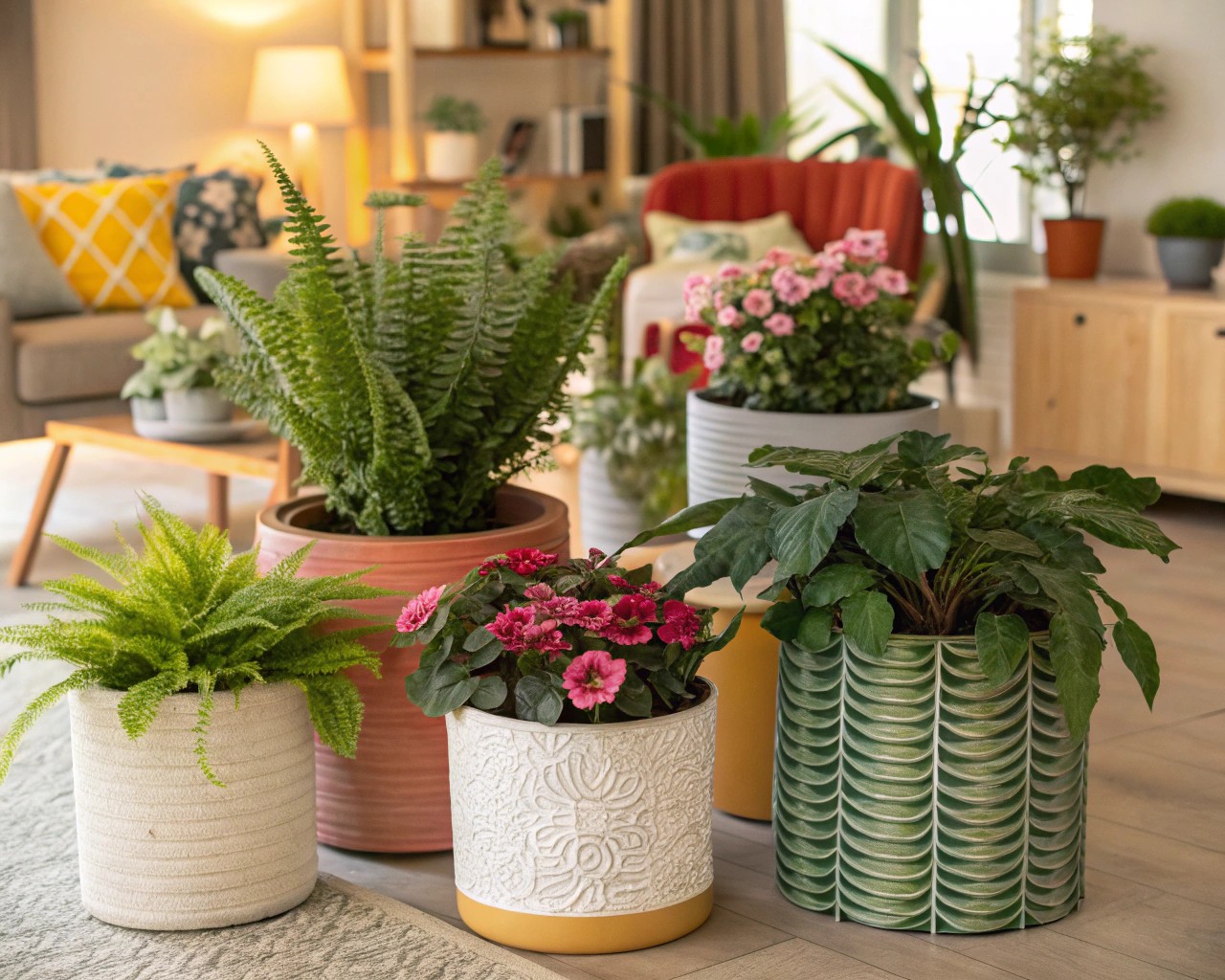
The container is as important as the plant itself—perhaps even more so from a design perspective.
Containers as Style Signifiers
It’s crucial to consider your home’s overall style when selecting planters. For instance, sleek Mid-Century Modern (MCM) planters complement contemporary interiors, whereas woven or rustic pots can add warmth suitable for bohemian or farmhouse aesthetics.
Here’s a quick reference guide for matching container styles to interior aesthetics:
| Interior Style | Ideal Container Types | Materials | Characteristics |
|---|---|---|---|
| Mid-Century Modern | Geometric, raised on legs | Ceramic, wood | Clean lines, tapered forms |
| Industrial | Utilitarian, sturdy | Concrete, metal | Raw finishes, visible hardware |
| Bohemian | Handcrafted, varied | Woven fibers, clay | Textural, irregular, patterned |
| Minimalist | Simple, understated | Matte ceramic, stone | Monochromatic, perfect proportions |
| Traditional | Classic shapes | Glazed ceramic, terracotta | Subtle details, symmetrical |
| Coastal | Light, airy | Whitewashed wood, rope | Bleached tones, natural textures |
Case Study: Coloplast Office Transformation
“Coloplast’s Minneapolis office is the American headquarters of a Danish medical device and medical supply manufacturer. Post-pandemic, Coloplast sought to create a warm, contemporary atmosphere that would encourage their hybrid workforce to return to the office, including natural light and lush plants”.
For this project, containers were selected to reference Danish design principles—simple forms, natural materials, and functional beauty. The planters were as carefully considered as the furniture, reinforcing the Scandinavian design heritage while creating a contemporary workspace.
Strategic Grouping for Maximum Impact
How plants are grouped dramatically affects their visual impact and the atmosphere they create.
The Microclimate Benefit
Grouping plants, particularly tropical varieties, offers a practical advantage. As they release moisture through transpiration, they collectively raise the humidity in their immediate vicinity, creating a beneficial microclimate that helps them thrive, especially in drier indoor environments.
This principle is particularly useful in dry environments where grouped plants maintain higher humidity for mutual benefit.
Visual Grouping Principles
For effective groupings, follow these core principles:
-
Plant Family Cohesion: “Make sure plants are from the same family, with similar needs – cacti, for example”.
-
Repetition with Variation: Use the same plant in different sizes or slightly different varieties for cohesive but interesting groupings.
-
Negative Space Importance: Allow for breathing room between grouped plants to prevent a cluttered appearance.
-
Container Relationship: Either match containers exactly or ensure they relate through color, material, or style.
-
Odd-Numbered Arrangements: Group in threes, fives, or sevens for natural-looking compositions.
Client Story: The Library Reading Nook
For a public library’s reading area, I created a plant grouping using various ferns in different sizes and textures. By maintaining visual cohesion through containers in varying shades of blue-green and strategic spacing between plants, we created a sense of lush abundance without overcrowding. Library patrons now specifically seek out this peaceful nook for reading and relaxation.
Plants as Space Definers
Intelligently placed plants can architecturally define areas within a space without solid barriers.
Natural Partitions and Boundaries
Plants can effectively create divisions within open spaces. You can apply this concept to:
- Separate dining areas from living spaces in open floor plans
- Create visual privacy for home office areas
- Define entryways in homes without formal foyers
- Establish meditation or reading corners within larger rooms
Case Study: The Home Office Boundary
For a client working from home in a studio apartment, we created a “plant wall” of varying heights to define her workspace. A tall dracaena at one end, mid-height calatheas in the middle, and cascading pothos at the other end created a sense of separation while maintaining airflow and light. The arrangement successfully signaled to both the resident and video call participants where the living space ended and the professional area began.
Seasonal Styling Considerations
Unlike permanent fixtures, plant arrangements can and should evolve with the seasons.
Seasonal Plant Styling Guide
| Season | Featured Plants | Container Colors | Styling Focus |
|---|---|---|---|
| Spring | Peace lilies, African violets | Pastels, light greens | Flowering specimens, new growth |
| Summer | Tropical foliage, colorful coleus | Vibrant blues, yellows | Maximum fullness, lush growth |
| Fall | Crotons, Chinese evergreens | Terracotta, amber, copper | Warmer tones, textural interest |
| Winter | Snake plants, ZZ plants, succulents | Whites, silvers, deep greens | Architectural forms, evergreen specimens |
Winter Plant Styling Success
Winter presents unique challenges for plant styling. With less natural light, position plants closer to windows and incorporate grow lights as design elements. During the darker months, I emphasize plants with interesting form rather than those that bloom, creating arrangements that rely on structure and texture rather than color.
In my own home, I created a stunning winter centerpiece using a collection of sansevieria varieties arranged in white ceramic containers of varying heights. The strong architectural forms provided visual interest even in low light conditions, and the arrangement required minimal maintenance during the winter vacation season.
Expert Plant Styling Tips from Professional Plant Stylists
Plant styling has emerged as a specialized profession in recent years. Here are insights from leading names in the field:
-
Hilton Carter: “Plants are not an inanimate object; it’s a living thing that is giving back to you. It’s providing not just a ‘look,’ but actually a lot of good energy. It’s a symbiotic sort of relationship that is happening between us and plants”.
-
Maryah Greene: Transformed from an elementary school teacher to a professional plant stylist by helping colleagues and friends care for their plants. Her approach emphasizes assessing spaces and selecting plants that match people’s needs and lifestyles.
-
Plant Choices for Impact: Plants featuring variegated foliage remain extremely popular in the houseplant trend landscape. Specimens with leaves displaying patterns like speckles, splashes, or veins in white, cream, yellow, silver, pink, or purple tend to be perceived as particularly stylish.

